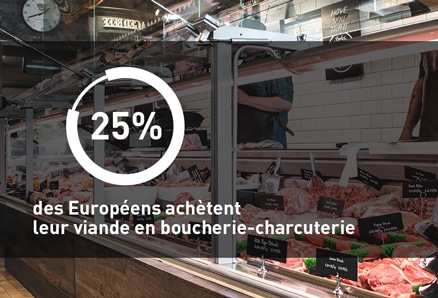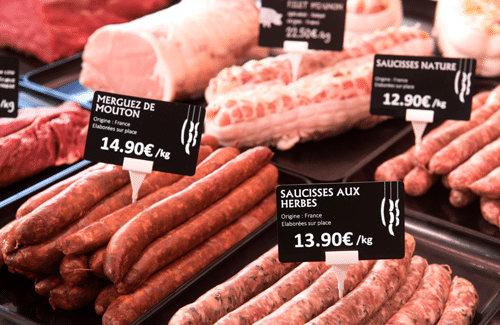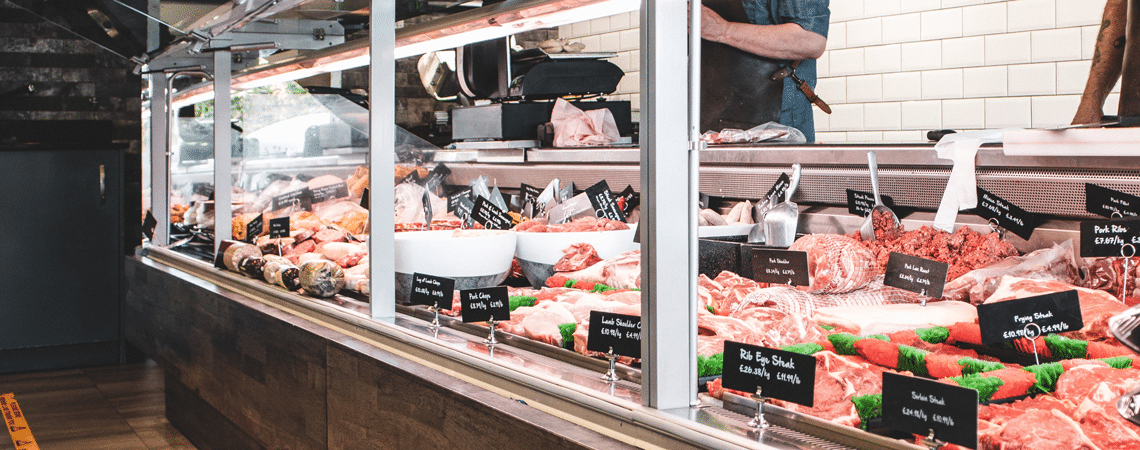Meat consumption trends have changed dramatically in recent years. The numerous health crises linked to the sector have increased the mistrust of customers, who are looking for as much information as possible about the products they consume, whatever they may be. Meat is still bought mainly in hypermarkets and supermarkets for 58% of Europeans, but 25% go to butchers and this figure is rising.
25% of Europeans buy their meat from butchers.

The important point is that, wherever they buy, consumers are increasingly looking for transparency in the products they buy. Alternatives to meat are also on the increase, and may seem like a threat to your business. However, it may just be a question of adapting and riding the wave of new consumer expectations so that meat can be seen as an essential, even irreplaceable, product.
Consumption habits and customer demands: 5 major challenges
Consuming less, but better: the advantage of local shops
This is the current consumer trend: "consume less, but better". Gone are the days of buying more with less. Customers now want access to quality products and are willing to pay the price on an exceptional rather than a regular basis. But to achieve this, they have a real need for information about the products they buy, and are becoming expert labellers, checking that the product in question meets their consumption criteria.
They therefore want easy access to information such as :
- The origin of the meat they eat According to a study carried out by the European Commission, 90% of Europeans want to know the origin of the meat they buy. This is of course not unrelated to the recent health crises.
But customers are also looking for short-distance supplies: In France, 94% of consumers think it is important that their butcher buys from local producers.
- Allergens present in the products they buy With the INCO law in Europe, the FASTER law in the United States and the Natasha law in the United Kingdom, transparency about allergens in products is a major expectation for consumers, but also a major constraint for you as a professional. It's a good idea to simplify their display and why not put them directly on your price labels for added convenience!
- Labels and awardsLabels and distinctions awarded to meats are a guarantee of quality for consumers. They provide reassurance about :
- production or manufacturing conditions, as for Label Rouge in France,
- AOC (Appellation d'Origine Contrôlée) or PDO (Protected Designation of Origin) in Europe,
- but also on the commitment to excellence of certain producers and craftsmen through awards given at trade fairs or consumer tests.
Organic farming is also an important purchasing criterion. 41% of Europeans want to increase their purchases of organically-farmed meat over the next few years. More than just a trend, this is a genuine choice that is committed to the environment.

- Home-made : "Consuming better" also means that processed products are not industrial, but homemade. 94% of French people think it's important for their Butchers, Delicatessens and Caterers to offer "home-made" products and this is true of all European countries. A "home-made" product has an image of being of better quality, because it is home-made and linked to the know-how of the retailer. This is a real advantage for local shops.
The 4 points mentioned above are an important source of information for consumers. They reassure them about what they are about to consume. So it's essential to make them easily available, and even to highlight them, to promote your products and their quality, and to be completely transparent about what you're selling. An easy-to-implement option for this is "all-in-one" labelling. A solution like Edikio Price Tag has software tailored to your business, allowing you to display allergens, labels and other important information directly on your price labels using pictograms or customised text.
Flexitarianism, vegetarianism and veganism: threats or opportunities?
The second issue linked to your business is consumption choices that involve reducing or stopping meat consumption altogether. In 2020, average meat consumption per capita in France will fall (- 1.7 %), from 86.0 kg per capita in 2019 to 84.5 kg per capita. Meat consumption down 2.1 %. These figures are set against the backdrop of the health crisis and the downward trend recorded over the last ten years: an average of 0.4 % per year between 2010 and 2019.
But this trend is not just French. An American has reduced his beef consumption by 33 % since 1970.
There are many reasons for this:
- Health recommendations: for example, the WHO has recommended reducing meat consumption.
- Ecological concerns: 66% of Europeans said they had reduced their meat consumption for ecological reasons.
Not to mention the growing popularity of vegetarianism and veganism:
- By 2040, it is estimated that vegan meat will account for 25% of sales.
- In the UK, almost 16% of teenagers and young adults no longer eat meat.
So, threat or opportunity?
In France, Interbev, the Association Nationale Interprofessionnelle du Bétail et des Viandes (National Interprofessional Livestock and Meat Association) has decided to turn this into a communication opportunity and advocate flexitarianism.. In this way, the profession is aligning itself with the trend for consumers to eat less meat, while at the same time communicating the fact that "being flexitarian means doing without" and therefore not stopping eating meat for all that. It's a great way of communicating about the butcher's trade in a roundabout way.
In shop, so don't hesitate to advise and reassure. And if you have a catering business, it might be worth offering vegetarian or vegan alternatives to attract new customers.

Stand out from the crowd and face up to the competition
Although the figures are tending to fall, the number of butchers and delicatessens, particularly in Europe, remains high. In Italy, there are almost 30,000 businesses in this sector, 24,000 in Spain and 18,000 in France. Not to mention the large market share of super/hypermarkets for meat purchases.
Whatever the size of your business, you'll need to :
- Maintaining your relationship with your regular customers
- Building loyalty among occasional or opportunistic customers
- Attracting new customers
So we talked about it above, and there are several angles of attack in each of the issues presented in this article:
- Promoting your expertise by clearly indicating your homemade products, your distinctions or by having a glassed-in area overlooking your laboratory...
- Adding value to your meat by labelling them in a professional and harmonious way, giving your customers all the information they need.
- Promote all the other products in your range as well in shop to highlight the diversity of what you have to offer.
- Finally develop your customer baseby setting up a loyalty card system to be stamped when making purchases.
Aesthetics: the importance of visuals for consumers
The aesthetics of your shop may seem insignificant compared with your products, but they are not something to be neglected. Did you know, for example, that improving the attractiveness of a sales outlet during a renovation is a major factor in increasing sales? The visual impact of your shop window accounts for 30 to 40% of sales. Quite simply because you are visually attracting customers who might not otherwise have stopped by.
What's more, in a butcher's shop :
- The attractiveness and prominence of products is the 3rd most important trigger for customers to make a purchase.
- 46% of consumers make up their minds only once they are in the sales outlet.
The attractiveness and prominence of products is the 3rd most important trigger for customers to make a purchase.
So don't miss out on these sales opportunities!
That's why,
- your customer's buying journey must be clear and practical,
- readable and detailed information,
- and thoughtful, professional aesthetics.
A simple way to meet these objectives is toadopt labelling that meets your needs and your customers' expectations. With all-in-one solutions like Edikio Price Tag designed for your profession, you can achieve an aesthetically harmonious and professional display. But you can also have labels that are easy to clean and that display all the information you need for your customers on the front, and for your staff on the back.

New buying habits, the development of click & collect
The final challenge is the development of online shopping habits. It is now estimated that almost 70% of consumers will be shopping online by 2025.. The health crisis of 2020 has only strengthened this habit, with 1 in 2 French people already doing their food shopping online.
This digitalisation of purchasing may seem a long way off for local butchers. However, other figures tend to prove that setting up a Click & Collect purchasing service can be worthwhile, even for small businesses:
- At the end of 2020, 85% of the French believe that it would be in the retailers' interest to strengthen their click and collect services.
- And 40% of customers who pick up an order say they have bought other products on the spot. Which proves that this service is not incompatible with in-store customer relations.
So what are the real advantages of a Click & Collect service for a butcher-caterer?
- You are for customers in a hurry who want to anticipate their purchases by doing them from home or from their lunch break at work.
- You attract and retain new customers, but also your regular customers with a new service.
- You increase the average shopping basket of your customers (+20% increase compared to a physical purchase), and you supplement this with "last minute" in-store purchases.
- Finally, you maintain physical contact with the customer, since in all cases they have to travel to pick up their order. They just save time by not having to choose their main purchases!
Case study: the Gicquel butcher's shop
The Gicquel butcher's shop had outdated labels, which were detracting from the aesthetics of the shop and therefore from its sales. The owner, who also offers delicatessen dishes, decided to replace his shop's labelling in order to meet his customers' expectations in terms of image and legibility.
It chose the all-in-one Edikio Price Tag Access solution to enable it to create and print the 150 price tags in its range.
He was convinced by :
- The ease of use of the Edikio Price Tag solution
- The professional, aesthetic look of its new price labels
- The intuitive software enables it to display all allergens directly on its labels.
"With the Edikio Access solution, the font is always the same and the pictograms illustrating the products and allergens are attractive and easy to understand.
